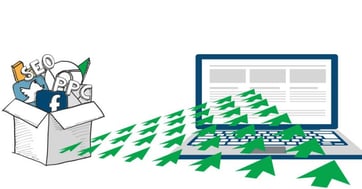|
What You’ll Learn:
|
Customer acquisition is the process of attracting new customers and turning them into loyal buyers. In today’s crowded digital landscape, mastering acquisition isn’t just about clicks—it’s about building meaningful relationships. By focusing on strategies like SEO, content marketing, and referrals, businesses can reduce acquisition costs, increase lifetime value, and fuel sustainable growth. Let’s look at 5 Key Components to Improve Customer Acquisition:
What is Customer Acquisition?
Think of customer acquisition as the process of turning curious browsers into paying customers. It’s all about guiding people from “Hmm, I’ve heard of them” to “Yes, I want to buy from them.” In simple terms, it’s how your business attracts and wins over new customers, whether that’s online, offline, or a smart combo of both.
Why Customer Acquisition is Important
Without customers, there’s no business; it’s as simple as that. Sure, brand awareness is great, but at the end of the day, you need real people buying your products or services. Customer acquisition matters because:
- It drives growth and revenue.
- It helps you stand out in a crowded market.
- It lays the foundation for customer loyalty, because a first purchase often leads to repeat ones.
In short, customer acquisition isn’t just about getting attention. It’s about creating long-term relationships that fuel your business for the future.

Key Customer Acquisition Strategies
So, how do you actually make customer acquisition happen? Here are some tried-and-true strategies:
Content Marketing
Create blogs, videos, guides, and other resources that answer your audience’s questions. When you provide value first, people are more likely to trust your brand and eventually become customers.
In 2025, 76% of marketers report that content marketing generates leads, and 82% of companies use content marketing in their strategies.
Search Engine Optimization (SEO)
Make sure your business shows up when people search for what you offer. Strong SEO means your website ranks higher, attracts the right audience, and brings in organic leads.
Paid Advertising (PPC & Social Ads)
Want faster results? Paid ads on Google, LinkedIn, or Facebook can put your brand in front of your target audience instantly. Great for testing offers and scaling quickly.
Email Marketing
Still one of the most effective channels. Use email campaigns to nurture leads with helpful updates, personalized offers, and timely reminders.
Social Media Marketing
Engage with your audience where they spend their time. Whether it’s Instagram, LinkedIn, or TikTok, consistent posting and interaction build relationships and drive conversions.
Referral Programs
Happy customers are your best sales team. Reward them for bringing in friends or colleagues, and you’ll gain loyal customers at a lower acquisition cost.
| Referrals are often your lowest-cost, highest-quality acquisition channel. |
Partnerships & Influencer Marketing
Collaborate with industry partners or influencers who already have your audience’s trust. It’s a shortcut to credibility and exposure.
Ways to Improve Customer Acquisition
1. Research the Right Direction
Start with a deep understanding of your target audience—their needs, challenges, and where they spend time online. Equally important is knowing your competitors. Use tools like site comparison reports to see how your brand measures up.
2. Creatively Craft and Curate
Personalized content is more effective. Customize your messages to the right audience, in the right format, at the right time. Data-driven personalization earns trust and improves conversions.
3. Frequently Analyze Activity
Acquisition is not guesswork. By implementing conversion tracking and marketing automation, you can continuously refine your campaigns to ensure you’re investing where it counts.
|
Acquisition without data is just guessing. |
4. Make Data Driven Marketing Decisions
Use analytics to uncover where customers engage most, and respond quickly to trends. For example, if potential customers are asking questions in forums, that’s a clear signal to boost local SEO or join the conversation.
5. Be Mobile Friendly First
Today, most browsing happens on mobile. A site that loads quickly and adapts seamlessly across devices is essential for both Google rankings and customer satisfaction. Modern acquisition success depends on mobile-first design and Core Web Vitals compliance.
Customer Acquisition Process
Winning new customers doesn’t happen by accident; it’s a step-by-step process that moves people from “I’ve never heard of you” to “Take my money.” Here’s how it usually works:
1. Awareness
First, people need to know you exist. This is where marketing campaigns, ads, SEO, and social media put your brand on their radar.
2. Interest
Once they’ve noticed you, it’s time to spark curiosity. Helpful content, engaging posts, or even a great offer can move potential customers from passive scrollers to genuinely interested leads.
3. Consideration
Here, prospects are weighing their options. They’re comparing you with competitors, reading reviews, and checking out your website. Strong messaging, case studies, and social proof help tip the scales in your favor.
4. Conversion
This is the moment they take action, making a purchase, signing up for a service, or booking a call. A smooth buying process and clear calls to action make all the difference.
5. Retention
Acquisition doesn’t end at the sale. Keep your new customers engaged with follow-up emails, loyalty programs, and great service. Why? Because a first-time buyer can easily become a repeat customer, and eventually an advocate for your brand.
Measuring Customer Acquisition Metrics
Getting new customers is exciting, but how do you know if your efforts are actually paying off? That’s where tracking the right customer acquisition metrics comes in. These numbers give you the full picture of what’s working, what’s not, and where to focus next.
CAC (Customer Acquisition Cost)

How much are you spending to bring in one new customer?
To put it simply:
CAC = Total Sales & Marketing Costs ÷ Number of New Customers Acquired
Example: If you spent $5,000 on campaigns this month and gained 50 new customers, your CAC is $100. Now the question is, are those $100 customers going to stick around and make it worth it?
CLV (Customer Lifetime Value)

This is where Customer Lifetime Value (CLV) comes in. CLV tells you how much revenue a customer is likely to generate during their entire relationship with your business. If your CLV is higher than your CAC, you’re in good shape. If it’s not? Time to rethink your acquisition strategies.
| If your CLV isn’t higher than your CAC, your acquisition strategy needs work. |
Acquisition Rate
Your acquisition rate is how many new customers you bring in over a set period, weekly, monthly, or quarterly. Tracking this helps you see whether your strategies are actually working or if you’re spending money without much return.
Conversion Rate
Out of all the leads you’re attracting, how many actually become paying customers? A strong conversion rate means your messaging and targeting are on point.
Return on Investment (ROI)
At the end of the day, are your acquisition campaigns generating more revenue than they cost? ROI helps you compare which channels and strategies deliver the best results.
Customer Acquisition Models
Not all acquisition looks the same. Some common models include:
Paid Acquisition

Customers gained through ads and promotions, such as Google Ads, paid social campaigns, or display ads. Fast results, but they usually come with higher costs.
Inbound Acquisition

Customers who find you through SEO, blogs, or social media. This model takes longer to build but is more sustainable and cost-effective in the long run.
Outbound Acquisition

Cold calls, outreach emails, or direct mail campaigns. It’s proactive and can work well for B2B or local services, though it often requires persistence.
Referral Acquisition

Happy customers bring in their friends through referral programs, reviews, or word of mouth. This is one of the most powerful (and cost-efficient) ways to grow because people trust recommendations.
Customer Acquisition vs Customer Retention
Here’s the big debate: should you focus more on getting new customers or keeping the ones you already have?
Acquisition is about growth, bringing new people into your world.
Retention is about loyalty, keeping existing customers happy so they stay and spend more.
The truth? You need both. Acquisition fills the funnel, and retention makes sure you’re not constantly starting from scratch. Think of it this way: acquisition wins attention, retention wins loyalty.

Contact Us and Improve Your Customer Acquisition Today
Bringing in new customers doesn’t have to feel like guesswork. With the right strategies and the right partner, you can turn more prospects into loyal, long-term customers.
At WSI, we help businesses just like yours sharpen their customer acquisition process through smarter marketing, better data insights, and strategies designed to actually work in today’s competitive market.
Whether you need help reducing your acquisition costs, choosing the right channels, or building a strategy that balances acquisition with retention, we’ve got you covered.
Ready to see more customers coming through your door (and sticking around)? Speak to an expert today to learn how to improve your customer acquisition.
|
FAQs 1. What industries rely most on customer acquisition? Industries like eCommerce, SaaS, real estate, healthcare, and financial services rely heavily on customer acquisition to stay competitive and scale quickly. 2. How long does the customer acquisition process usually take? It depends on your industry and sales cycle. eCommerce brands may convert customers in minutes, while B2B companies might need weeks or months of nurturing before closing a deal. 3. What role does branding play in customer acquisition? Branding builds trust and recognition. A strong, consistent brand makes acquisition easier because people are more likely to choose a business they recognize and trust. 4. How has AI changed customer acquisition? AI helps businesses personalize marketing, predict customer behavior, and automate outreach. It allows for smarter targeting and faster decision-making, which makes acquisition more efficient. 5. Can customer acquisition be automated? Parts of it can. Marketing automation platforms can handle lead nurturing, follow-up emails, retargeting ads, and even chatbots, freeing up your team to focus on strategy. 6. What’s the most cost-effective customer acquisition method? Referrals and word-of-mouth are often the most affordable and effective methods since they rely on happy customers promoting your brand. 7. How does social proof impact customer acquisition? Reviews, testimonials, and case studies reassure potential customers that your business delivers on its promises, making them more likely to choose you over competitors. 8. Do offline methods still matter for customer acquisition? Yes. Networking events, trade shows, direct mail, and even print ads can still drive new customers, especially when combined with digital strategies. 9. What’s the difference between B2B and B2C customer acquisition? B2B acquisition usually involves longer sales cycles, more decision-makers, and personalized outreach, while B2C is faster and often influenced by emotions, convenience, and brand appeal. 10. How can customer acquisition efforts improve retention? When you acquire the right customers (those aligned with your brand and values), they’re more likely to stick around. Good acquisition sets the stage for strong retention. |






